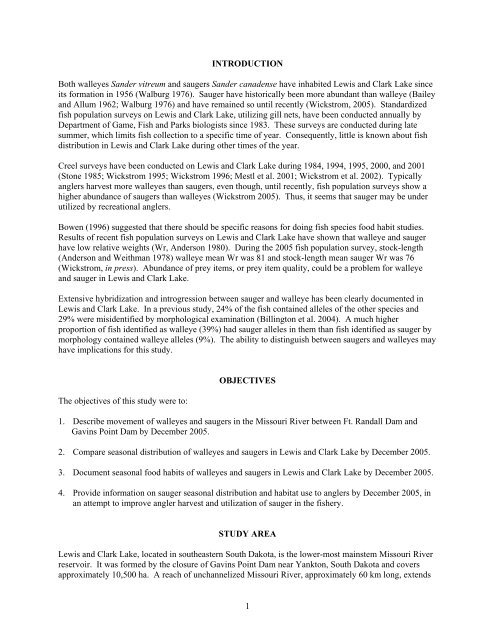Seasonal Distribution, Movement and Food Habits ... - e.library-Home
Seasonal Distribution, Movement and Food Habits ... - e.library-Home
Seasonal Distribution, Movement and Food Habits ... - e.library-Home
Create successful ePaper yourself
Turn your PDF publications into a flip-book with our unique Google optimized e-Paper software.
INTRODUCTION<br />
Both walleyes S<strong>and</strong>er vitreum <strong>and</strong> saugers S<strong>and</strong>er canadense have inhabited Lewis <strong>and</strong> Clark Lake since<br />
its formation in 1956 (Walburg 1976). Sauger have historically been more abundant than walleye (Bailey<br />
<strong>and</strong> Allum 1962; Walburg 1976) <strong>and</strong> have remained so until recently (Wickstrom, 2005). St<strong>and</strong>ardized<br />
fish population surveys on Lewis <strong>and</strong> Clark Lake, utilizing gill nets, have been conducted annually by<br />
Department of Game, Fish <strong>and</strong> Parks biologists since 1983. These surveys are conducted during late<br />
summer, which limits fish collection to a specific time of year. Consequently, little is known about fish<br />
distribution in Lewis <strong>and</strong> Clark Lake during other times of the year.<br />
Creel surveys have been conducted on Lewis <strong>and</strong> Clark Lake during 1984, 1994, 1995, 2000, <strong>and</strong> 2001<br />
(Stone 1985; Wickstrom 1995; Wickstrom 1996; Mestl et al. 2001; Wickstrom et al. 2002). Typically<br />
anglers harvest more walleyes than saugers, even though, until recently, fish population surveys show a<br />
higher abundance of saugers than walleyes (Wickstrom 2005). Thus, it seems that sauger may be under<br />
utilized by recreational anglers.<br />
Bowen (1996) suggested that there should be specific reasons for doing fish species food habit studies.<br />
Results of recent fish population surveys on Lewis <strong>and</strong> Clark Lake have shown that walleye <strong>and</strong> sauger<br />
have low relative weights (Wr, Anderson 1980). During the 2005 fish population survey, stock-length<br />
(Anderson <strong>and</strong> Weithman 1978) walleye mean Wr was 81 <strong>and</strong> stock-length mean sauger Wr was 76<br />
(Wickstrom, in press). Abundance of prey items, or prey item quality, could be a problem for walleye<br />
<strong>and</strong> sauger in Lewis <strong>and</strong> Clark Lake.<br />
Extensive hybridization <strong>and</strong> introgression between sauger <strong>and</strong> walleye has been clearly documented in<br />
Lewis <strong>and</strong> Clark Lake. In a previous study, 24% of the fish contained alleles of the other species <strong>and</strong><br />
29% were misidentified by morphological examination (Billington et al. 2004). A much higher<br />
proportion of fish identified as walleye (39%) had sauger alleles in them than fish identified as sauger by<br />
morphology contained walleye alleles (9%). The ability to distinguish between saugers <strong>and</strong> walleyes may<br />
have implications for this study.<br />
The objectives of this study were to:<br />
OBJECTIVES<br />
1. Describe movement of walleyes <strong>and</strong> saugers in the Missouri River between Ft. R<strong>and</strong>all Dam <strong>and</strong><br />
Gavins Point Dam by December 2005.<br />
2. Compare seasonal distribution of walleyes <strong>and</strong> saugers in Lewis <strong>and</strong> Clark Lake by December 2005.<br />
3. Document seasonal food habits of walleyes <strong>and</strong> saugers in Lewis <strong>and</strong> Clark Lake by December 2005.<br />
4. Provide information on sauger seasonal distribution <strong>and</strong> habitat use to anglers by December 2005, in<br />
an attempt to improve angler harvest <strong>and</strong> utilization of sauger in the fishery.<br />
STUDY AREA<br />
Lewis <strong>and</strong> Clark Lake, located in southeastern South Dakota, is the lower-most mainstem Missouri River<br />
reservoir. It was formed by the closure of Gavins Point Dam near Yankton, South Dakota <strong>and</strong> covers<br />
approximately 10,500 ha. A reach of unchannelized Missouri River, approximately 60 km long, extends<br />
1



